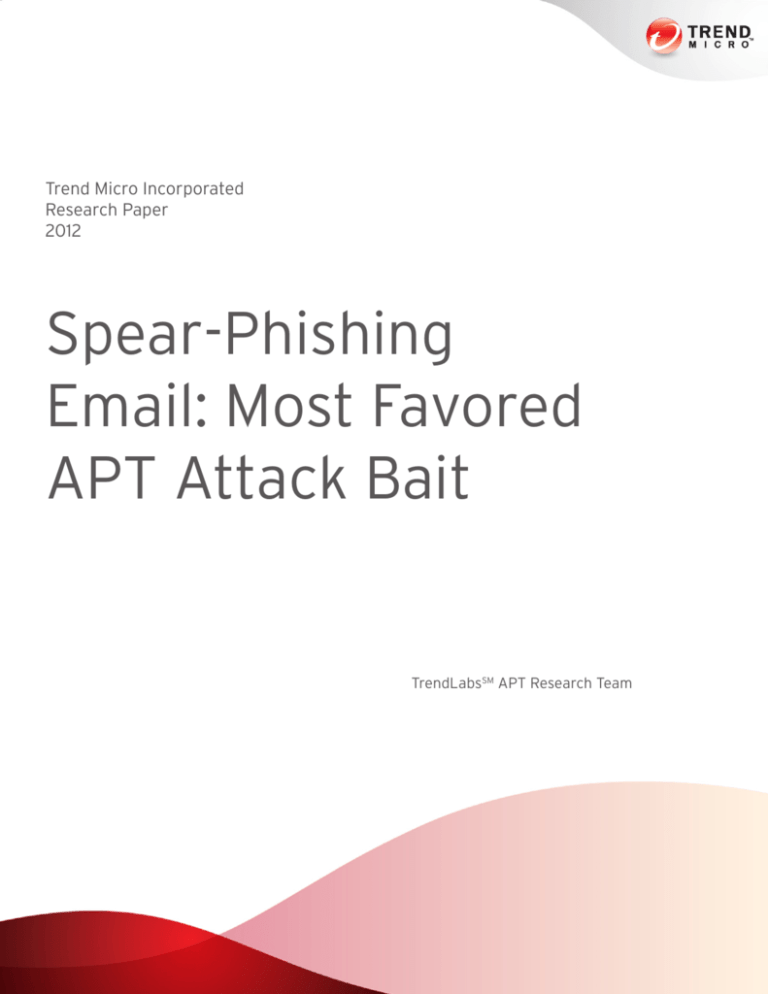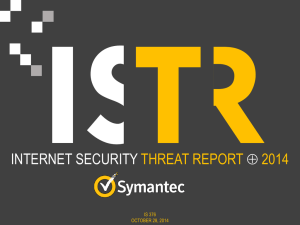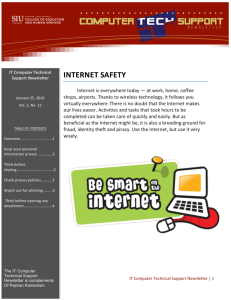
Trend Micro Incorporated
Research Paper
2012
Spear-Phishing
Email: Most Favored
APT Attack Bait
TrendLabsSM APT Research Team
Contents
Introduction............................................................................................................................................ 1
What Is Spear Phishing?...................................................................................................................... 1
Spear-Phishing Attack Ingredients................................................................................................... 2
The Email......................................................................................................................................... 2
The Attachment............................................................................................................................. 2
The Usual Targets.......................................................................................................................... 3
Most Targeted Industries.............................................................................................................4
Most Targeted Regions................................................................................................................ 5
Spear Phishing for Reconnaissance................................................................................................. 5
Conclusion.............................................................................................................................................. 6
PAGE ii | SPEAR-PHISHING EMAIL: MOST FAVORED APT ATTACK BAIT
Introduction
What Is Spear Phishing?
Advanced persistent threat (APT) campaigns comprise
a growing part of the current threat landscape. Some
APT campaigns remain active, in fact, even after drawing
extensive media attention. Campaigns’ routines may vary
over time but their primary goal remains the same—to
gain entry to a target organization’s network and obtain
confidential information.
Spear phishing may be defined as “highly targeted
phishing aimed at specific individuals or groups within an
organization.” Coined as a direct analogue to spearfishing,
spear phishing makes the use of information about a
target to make attacks more specific and “personal” to
the target.3 Spear-phishing emails, for instance, may refer
to their targets by their specific name, rank, or position
instead of using generic titles as in broader phishing
campaigns.4
Spear phishing continues to be a favored means by APT
attackers to infiltrate target networks. In a typical spearphishing attack, a specially crafted email is sent to specific
individuals from a target organization. The recipients are
convinced through clever and relevant social engineering
tactics to either download a malicious file attachment
or to click a link to a malware- or an exploit-laden site,
starting a compromise.
While spear phishing may be a timeworn technique,
it continues to be effective even in today’s Web 2.0
landscape. In 2011, security firm RSA suffered a breach via
a targeted attack. Analysis revealed that the compromise
began with the opening of a spear–phishing email.1 That
same year, email service provider Epsilon also fell prey to a
spear-phishing attack that caused the organization to lose
an estimated US$4 billion.2
APT campaigns frequently make use of spear-phishing
tactics because these are essential to get high-ranking
targets to open phishing emails. These targets may either
be sufficiently aware of security best practices to avoid
ordinary phishing emails or may not have the time to read
generic-sounding messages. Spear phishing significantly
raises the chances that targets will read a message that
will allow attackers to compromise their networks. In
many cases, spear-phishing emails use attachments made
to appear as legitimate documents because sharing via
email is a common practice among large enterprises
and government organizations—the usual targets of APT
campaigns.
This research paper presents Trend Micro findings on APTrelated spear phishing from February to September 2012.
We analyzed APT-related spear-phishing emails collected
throughout this period to understand and mitigate attacks.
The information we gathered not only allowed us to obtain
specific details on spear phishing but also on targeted
attacks. We found, for instance, that 91% of targeted
attacks involve spear-phishing emails, reinforcing the
belief that spear phishing is a primary means by which
APT attackers infiltrate target networks.
1 http://blogs.rsa.com/rivner/anatomy-of-an-attack/
2 http://www.informationweek.com/security/attacks/epsilon-fell-tospear-phishing-attack/229401372 and http://www.net-security.org/
secworld.php?id=10966
3 http://en.wikipedia.org/wiki/Spearfishing
4 http://about-threats.trendmicro.com/Glossary.
aspx?index=P&language=au
PAGE 1 | SPEAR-PHISHING EMAIL: MOST FAVORED APT ATTACK BAIT
Spear-Phishing Attack Ingredients
The Email
The Attachment
In a spear-phishing attack, a target recipient is lured to
either download a seemingly harmless file attachment
or to click a link to a malware- or an exploit-laden site.
The file, often a vulnerability exploit, installs a malware
in a compromised computer. The malware then accesses
a malicious command-and-control (C&C) server to await
instructions from a remote user. At the same time, it
usually drops a decoy document that will open when the
malware or exploit runs to hide malicious activity.
Spear-phishing emails can have attachments of varying
file types. We found that the most commonly used
and shared file types in organizations (e.g., .XLS, .PDF,
.DOC, .DOCX, and .HWP) accounted for 70% of the total
number of spear-phishing email attachments during our
monitoring.
Figure 1: Infection chain that starts when a spear-phishing email is opened
PAGE 2 | SPEAR-PHISHING EMAIL: MOST FAVORED APT ATTACK BAIT
Figure 2: Top spear-phishing email attachment file types
Figure 3: Ratio of targeted emails with attachments to those
without attachments
Executable (.EXE) files were not commonly used as spearphishing email attachments. This is likely due to the fact
that emails with .EXE file attachments are usually detected
and blocked by any security solution. This is also why
.EXE files are usually compressed and archived before
being sent. They instead came in the form of .LZH, .RAR,
and .ZIP files. In some cases, compressed files were even
password protected to further prevent their malicious
content from being detected by security solutions. The
passwords are indicated in the email body along with the
social engineering bait.
When attached executable files are extracted, they
generally look suspicious. That is why malicious executable
files often come disguised as documents with fake icons,
employ the right-to-left override (RLO) technique, and use
file names appended with many spaces to hide the .EXE
file name extension.5
People normally share files (e.g., reports, business
documents, and resumes) in the corporate or government
setting via email. This may be due to the fact that
downloading off the Internet in such a setting is frowned
upon. That is why a higher number of spear-phishing
emails with attachments is sent to targets in the corporate
or government sector.
Targeted emails without attachments are more often sent
to noncorporate or nongovernmental organization (NGO)
targets like activist groups and international organizations
as their members typically reside in different countries. In
such a case, a spear-phishing email that lures victims to
click a link and to download a file from a remote site may
not appear suspicious.
The Usual Targets
Monitoring revealed that 94% of targeted emails use
malicious file attachments while the rest use alternative
methods like installing malware by luring victims to click
malicious links and to download malicious files and using
webmail exploits.6
5 http://krebsonsecurity.com/2011/09/right-to-left-override-aids-emailattacks/
6 http://blog.trendmicro.com/trendlabs-security-intelligence/targetedattacks-on-popular-web-mail-services-signal-future-attacks/
Figure 4: Ratio of APT corporate/government sector targets to
noncorporate/NGO targets
PAGE 3 | SPEAR-PHISHING EMAIL: MOST FAVORED APT ATTACK BAIT
Most Targeted Industries
Throughout the eight months we have been monitoring
APT-related spear-phishing attacks, the government sector
and activist groups proved to be most targeted.
Activist groups often have social media pages apart from
their own sites. These online pages usually contain points
of contact along with member information to facilitate
information exchange, to organize campaigns, or to recruit
new members. In this case, information availability may
make them easier targets.
Apart from being a common cyber-espionage target, the
government sector also topped the list of most targeted
industries related to APTs. This may most probably be due
to how accessible pertinent information about government
agencies is on the Internet. Government agencies are
likely to share contact information on their websites as
they serve the public. Information on appointed members
is also readily available to the public via government sites.
Figure 5: Most common industry targets of APT-related spear phishing
PAGE 4 | SPEAR-PHISHING EMAIL: MOST FAVORED APT ATTACK BAIT
Spear Phishing for Reconnaissance
Most Targeted Regions
As part of protecting customers and their valuable data,
Trend Micro consistently monitors and mitigates possible
targeted attacks. The following figure shows the number
of possible targeted attacks we have seen over the
monitoring period, the majority of which were related to
spear phishing.
Figure 6: Most common regional targets of APT-related spear
phishing
To increase the likelihood that a targeted attack would
succeed, attackers first perform reconnaissance on their
chosen targets. Reconnaissance is defined as “profiling
a target in order to acquire information concerning its
defensive posture and software deployment status and a
contextual understanding of the roles and responsibilities
key personnel play and relevant themes to employ in social
engineering.”7 Reconnaissance can be further classified
into two stages—pre- and post-infiltration reconnaissance.
Pre-infiltration reconnaissance is more generally
associated with the human aspect. In this stage, attackers
profile their human targets to gain initial entry to a target
network. The delivery method, for instance, via a spearphishing email often leveraging social engineering, is
also determined. While human-related information like a
target’s name, job title, and email address may be bought
from the underground market or be provided by the
masterminds behind sanctioned attacks, the Internet is
the most convenient source of such information. Social
networking sites, corporate and academic publications,
and organizations’ sites allow miscreants to harvest
relevant information on their targets for various social
engineering schemes.
Pre-infiltration reconnaissance allows attackers to identify
persons of interest in an organization. These people
are usually in high positions in a targeted organization,
individuals who may have copies of the documents or
have access to the type of data attackers go after. Once
identified, the attackers will obtain their email addresses
for spear-phishing purposes.
Trend Micro research revealed that nearly half of the total
number of spear-phishing recipient email addresses was
just a Google search away.
7 http://www.trendmicro.co.uk/media/wp/apt-primer-whitepaper.pdf
PAGE 5 | SPEAR-PHISHING EMAIL: MOST FAVORED APT ATTACK BAIT
Conclusion
Spear phishing remains the most favored vector for
instigating targeted attacks. Why? Because users continue
to fall prey to spear-phishing emails, causing substantial
damage to their respective organizations. Spear-phishing
email attachments are difficult to spot from normal
document attachments passed on from user to user each
day in a corporate environment, increasing the likelihood
of successful computer infection.
Figure 7: Ratio of spear-phishing recipient email addresses on the
web to those that are not
More than half of the email addresses that did not appear
in Google searches can be found by typing a target
recipient’s name with his/her company’s email account
domain name like recipient’s_name@company_name.
com. This means that three-fourths of the total number of
spear-phishing-related email addresses we collected was
easily obtainable from the web.
The availability of organizational information on the
Internet allow attackers to gain relevant data on their
chosen targets, making their APT campaigns more
effective. Our findings highlight how spear phishing aids
APT attacks because of the vast amount of information
available at the touch of our fingertips. Organizations
should strive to improve their existing defenses and take
into careful consideration what types of and how much
information they make available online.
Post-infiltration reconnaissance, on the other hand,
is conducted after a remote access Trojan (RAT) has
successfully been installed in a victim’s computer. In this
stage, an attacker can use the RAT to profile the target
network. Profiling includes knowing what OS and security
software the victim’s machine runs and obtaining access
to local IP addresses, proxy servers, and other machines
in the network. All of this information is used to maintain
persistence, to perform lateral movement, and to exfiltrate
data from the target network.
TREND MICRO™
TREND MICRO INC.
Trend Micro Incorporated (TYO: 4704; TSE: 4704), a global cloud security
leader, creates a world safe for exchanging digital information with its Internet content security and threat management solutions for businesses
and consumers. A pioneer in server security with over
20 years’ experience, we deliver top-ranked client, server and cloudbased security that fits our customers’ and partners’ needs, stops
new threats faster, and protects data in physical, virtualized and cloud
environments. Powered by the industry-leading Trend Micro™ Smart Protection Network™ cloud computing security infrastructure, our products
and services stop threats where they emerge—from the Internet. They are
supported by 1,000+ threat intelligence experts around the globe.
10101 N. De Anza Blvd.
Cupertino, CA 95014
U.S. toll free: 1 +800.228.5651
Phone: 1 +408.257.1500
Fax: 1 +408.257.2003
www.trendmicro.com
©2012 by Trend Micro, Incorporated. All rights reserved. Trend Micro and the Trend Micro t-ball logo are trademarks or registered trademarks of Trend Micro, Incorporated. All other product or company
names may be trademarks or registered trademarks of their owners.
PAGE 6 | SPEAR-PHISHING EMAIL: MOST FAVORED APT ATTACK BAIT







